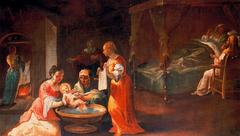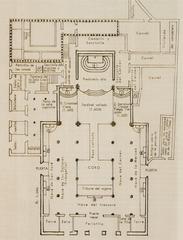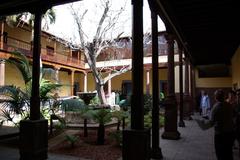
Cathedral of La Laguna: Visiting Hours, Tickets & Historical Guide
Date: 14/06/2025
Introduction
The Cathedral of La Laguna, officially known as the Cathedral of Nuestra Señora de los Remedios, sits at the heart of San Cristóbal de La Laguna, Tenerife. This architectural masterpiece is a cornerstone of the island’s cultural and religious identity and is recognized as a UNESCO World Heritage site (UNESCO). From its origins as a modest 16th-century parish church to its current grandeur blending Neoclassical and Neo-Gothic styles, the cathedral has evolved alongside the city, serving as both a spiritual haven and a symbol of La Laguna’s historical significance. This guide provides comprehensive details on visiting hours, ticketing, accessibility, architectural highlights, and tips for maximizing your experience in this remarkable landmark.
Table of Contents
- Historical Overview
- Architectural Evolution
- Cultural and Religious Importance
- Visitor Information
- Architectural and Artistic Features
- Urban and Social Context
- Nearby Attractions
- Restoration and Preservation
- Frequently Asked Questions (FAQs)
- Plan Your Visit
- References
Historical Overview
The Cathedral of La Laguna traces its roots back to the early 16th century, shortly after the founding of San Cristóbal de La Laguna in 1496 during the Spanish conquest of the Canary Islands. The site initially housed a hermitage, which was soon replaced by a mudéjar-style church in 1515, characterized by its timberwork and decorative motifs (History Hit; Spain.info). As La Laguna rose to prominence, the church was expanded with new chapels and altarpieces, reflecting the city’s growing religious and civic importance.
In 1819, the church was elevated to cathedral status with the establishment of the Diocese of San Cristóbal de La Laguna. The current cathedral, constructed between 1904 and 1915, is the result of successive reconstructions that blend Neoclassical and Neo-Gothic styles (Patrimonio Mundial La Laguna).
Architectural Evolution
Exterior Features
The cathedral’s Neoclassical façade, completed in 1820 and inspired by the Cathedral of Pamplona, is distinguished by its symmetrical columns and triangular pediment (Wikipedia). The right tower, finished in 1916, and the prominent Neo-Gothic dome with ribbed structure and lantern, define the city’s skyline (Go Tenerife).
Interior Design
The interior, redesigned in the early 20th century, features three Neo-Gothic naves separated by slender columns supporting high ribbed vaults (Patrimonio Mundial La Laguna). The ambulatory leads to side chapels adorned with altarpieces and religious art spanning several centuries (Web Tenerife).
Artistic Highlights
- El Cristo de los Remedios: A 16th-century crucifix, one of the island’s earliest sacred art pieces.
- Nuestra Señora de La Luz: A polychrome sculpture attributed to Juan Bautista Vázquez el Viejo, considered the cathedral’s finest artwork.
- Carrara Marble Pulpit: Crafted in 1762 by Pascuale Bocciardo.
- Retablo de Mazuelos: Intricately carved altarpieces, a legacy from the original parish church.
- Rococo Monstrance: A gold-plated silver monstrance used in processions (Web Tenerife).
Cultural and Religious Importance
The cathedral serves as the seat of the Roman Catholic Diocese of San Cristóbal de La Laguna, making it the principal church for Catholics on Tenerife (guidetocanaryislands.com). Dedicated to the Virgin of Los Remedios, it hosts major liturgical celebrations, processions, and community events. The cathedral’s art and architecture embody the island’s spiritual and cultural heritage, and its festivals—including Holy Week and the Feast of the Virgin of Los Remedios—draw visitors from across the region.
Visitor Information
Visiting Hours
- Cultural Visits: Monday to Friday: 09:00–18:00; Saturday: 09:30–12:30; Sunday: closed for cultural visits.
- Religious Services: Entry is always free for worship; however, some areas may be restricted during services.
Hours may vary during holidays or special events. For the latest schedule, consult the official cathedral website.
Tickets and Admission
- General Entry: Paid admission for cultural visits includes a multilingual audio guide (Spanish, English, French, German, Italian).
- Worship: Free entry during religious services; audio guide costs €2 if used during these times.
See the official website for current prices and booking details.
Accessibility
The cathedral is wheelchair accessible at the main entrance and nave. Some historic chapels may have restricted access. Restrooms are available, and assistance can be requested.
Guided Tours
Guided tours are available in several languages and provide in-depth information on the cathedral’s history, architecture, and religious art. These may require advance booking and an additional fee.
Travel Tips
- Best Visiting Time: Early mornings or late afternoons to avoid crowds.
- Photography: Permitted for personal use without flash or tripods, especially during religious services.
- Facilities: No cloakroom or luggage storage; gift shop near the entrance for religious items and souvenirs.
Architectural and Artistic Features
- Neoclassical Façade: Grand portico with Corinthian columns and triangular pediment.
- Neo-Gothic Dome: A city landmark, visible from many vantage points.
- Interior: Three naves, soaring columns, and ribbed vaults.
- Chapels and Ambulatory: Houses significant sculptures, paintings, and liturgical objects, including works by Luján Pérez and Fernando Estévez.
- Treasury: Collection of sacred ornaments and silverware from the Canary Islands, Spain, and the Americas (Web Tenerife).
Urban and Social Context
The cathedral’s central position in Plaza de Nuestra Señora de los Remedios reflects La Laguna’s Renaissance-inspired grid layout, a model for later colonial cities in the Americas (Spain.info). The city’s urban design, with the cathedral as a focal point, underscores its role as both a spiritual and civic hub (UNESCO).
Nearby Attractions
- Plaza del Adelantado: Historic square with local cafés and shops.
- Palacio de Nava & Casa de los Capitanes Generales: Outstanding colonial architecture.
- Teatro Leal: A modernist theater.
- Church of the Conception & Santa Catalina Monastery: Additional historical sites within walking distance.
For further exploration, visit Visit Canary Islands and Go Tenerife.
Restoration and Preservation
The cathedral underwent major restoration between 2002 and 2014, addressing structural issues in the dome and tower and conserving invaluable artworks (History Hit). Ongoing preservation efforts ensure its historical and architectural legacy endures for future generations.
Frequently Asked Questions (FAQs)
Q: What are the visiting hours of the Cathedral of La Laguna?
A: Monday to Friday: 09:00–18:00; Saturday: 09:30–12:30; Sunday: closed for cultural visits. Hours may change on holidays.
Q: Is there an entrance fee?
A: Yes, for cultural visits. Free for worshippers; audio guides are available for a small fee.
Q: Are guided tours available?
A: Yes, guided tours are available in multiple languages.
Q: Is the cathedral wheelchair accessible?
A: Yes, main entrance and nave are accessible; some areas may have limited access.
Q: Can I take photographs?
A: Yes, photography is allowed except during services; avoid flash and tripods.
Q: What else can I visit nearby?
A: Plaza del Adelantado, Church of the Conception, museums, and colonial architecture.
Plan Your Visit
- Check current visiting hours and event schedules before your trip.
- Book guided tours in advance if required.
- Explore nearby San Cristóbal de La Laguna historical sites for a complete cultural experience.
- Download the Audiala app for exclusive audio tours and local insights.
References and Further Reading
- Visit Canary Islands
- History Hit
- Spain.info
- Patrimonio Mundial La Laguna
- La Laguna Cathedral Official Website
- UNESCO World Heritage Centre
- Canary Islands Guide
- Go Tenerife
- Web Tenerife


